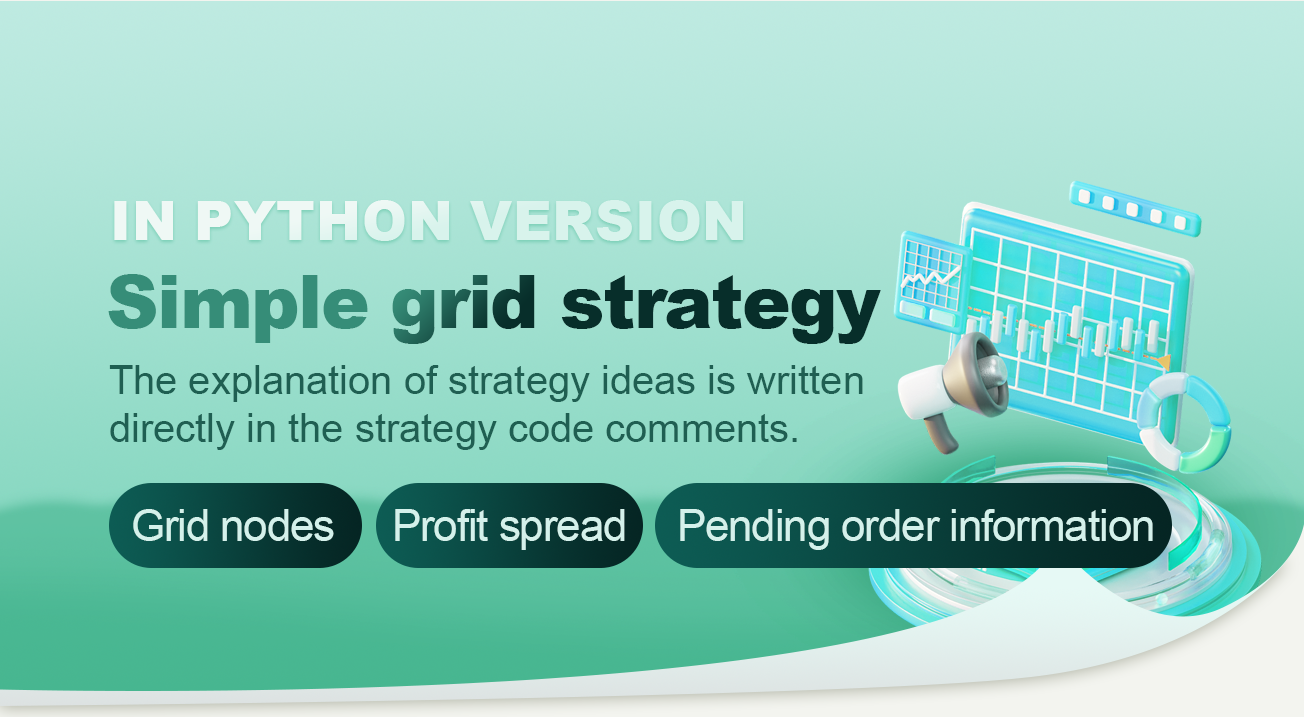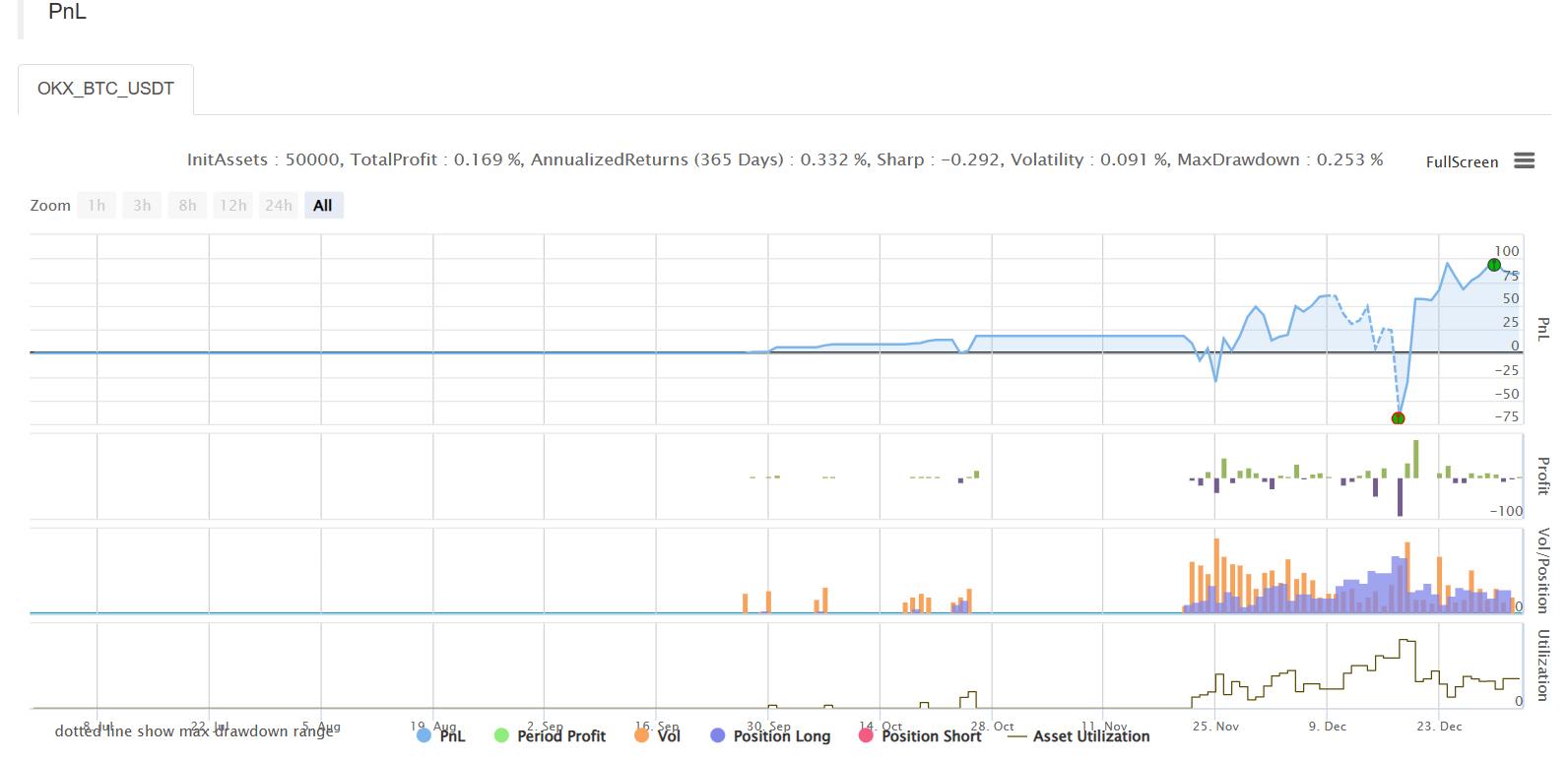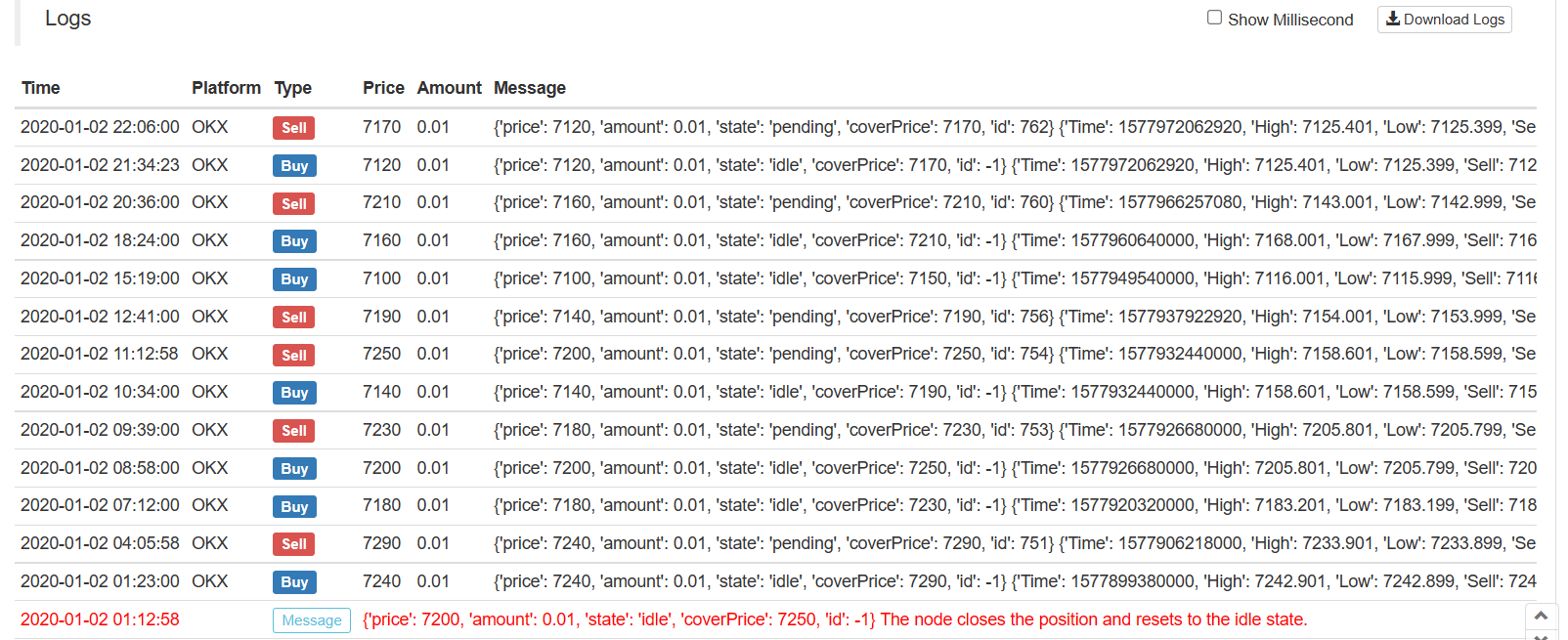Einfache Rasterstrategie in Python Version
Schriftsteller:FMZ~Lydia, Erstellt: 2022-12-23 21:00:45, Aktualisiert: 2025-01-11 18:19:24
Einfache Rasterstrategie in Python Version
Es gibt nicht viele Python-Strategien auf dem Strategie-Quadrat. Hier wird eine Python-Version der Gitterstrategie geschrieben. Das Prinzip der Strategie ist sehr einfach. Eine Reihe von Gitterknoten werden durch eine feste Preisdistanz innerhalb einer Preisspanne erzeugt. Wenn der Markt sich ändert und der Preis eine Gitterknotenpreisposition erreicht, wird eine Kauforder platziert. Wenn die Bestellung geschlossen wird, dh nach dem Preis der ausstehenden Bestellung plus der Gewinnspanne, warten Sie auf eine Verkaufsorder, um die Position zu schließen.
Es versteht sich von selbst, dass das Risiko der Gitterstrategie darin besteht, dass jede Gitterstrategie eine Wette ist, dass der Preis in einem bestimmten Bereich schwankt. Sobald der Preis aus dem Gitterbereich herausbricht, kann dies zu ernsthaften schwimmenden Verlusten führen. Daher ist der Zweck des Schreibens dieser Strategie, eine Referenz für Python-Strategie-Schreibideen oder Programmdesign zu bieten. Diese Strategie wird nur zum Lernen verwendet und kann im echten Bot riskant sein.
Die Erläuterung der Strategieideen ist direkt in den Kommentaren zum Strategiecode geschrieben.
Strategiecode
'''backtest
start: 2019-07-01 00:00:00
end: 2020-01-03 00:00:00
period: 1m
exchanges: [{"eid":"OKEX","currency":"BTC_USDT"}]
'''
import json
# Parameters
beginPrice = 5000 # Grid interval begin price
endPrice = 8000 # Grid interval end price
distance = 20 # Price distance of each grid node
pointProfit = 50 # Profit spread per grid node
amount = 0.01 # Number of pending orders per grid node
minBalance = 300 # Minimum fund balance of the account (at the time of purchase)
# Global variables
arrNet = []
arrMsg = []
acc = None
def findOrder (orderId, NumOfTimes, ordersList = []) :
for j in range(NumOfTimes) :
orders = None
if len(ordersList) == 0:
orders = _C(exchange.GetOrders)
else :
orders = ordersList
for i in range(len(orders)):
if orderId == orders[i]["Id"]:
return True
Sleep(1000)
return False
def cancelOrder (price, orderType) :
orders = _C(exchange.GetOrders)
for i in range(len(orders)) :
if price == orders[i]["Price"] and orderType == orders[i]["Type"]:
exchange.CancelOrder(orders[i]["Id"])
Sleep(500)
def checkOpenOrders (orders, ticker) :
global arrNet, arrMsg
for i in range(len(arrNet)) :
if not findOrder(arrNet[i]["id"], 1, orders) and arrNet[i]["state"] == "pending" :
orderId = exchange.Sell(arrNet[i]["coverPrice"], arrNet[i]["amount"], arrNet[i], ticker)
if orderId :
arrNet[i]["state"] = "cover"
arrNet[i]["id"] = orderId
else :
# Cancel
cancelOrder(arrNet[i]["coverPrice"], ORDER_TYPE_SELL)
arrMsg.append("Pending order failed!" + json.dumps(arrNet[i]) + ", time:" + _D())
def checkCoverOrders (orders, ticker) :
global arrNet, arrMsg
for i in range(len(arrNet)) :
if not findOrder(arrNet[i]["id"], 1, orders) and arrNet[i]["state"] == "cover" :
arrNet[i]["id"] = -1
arrNet[i]["state"] = "idle"
Log(arrNet[i], "The node closes the position and resets to the idle state.", "#FF0000")
def onTick () :
global arrNet, arrMsg, acc
ticker = _C(exchange.GetTicker) # Get the latest current ticker every time
for i in range(len(arrNet)): # Iterate through all grid nodes, find out the position where you need to pend a buy order according to the current market, and pend a buy order.
if i != len(arrNet) - 1 and arrNet[i]["state"] == "idle" and ticker.Sell > arrNet[i]["price"] and ticker.Sell < arrNet[i + 1]["price"]:
acc = _C(exchange.GetAccount)
if acc.Balance < minBalance : # If there is not enough money left, you can only jump out and do nothing.
arrMsg.append("Insufficient funds" + json.dumps(acc) + "!" + ", time:" + _D())
break
orderId = exchange.Buy(arrNet[i]["price"], arrNet[i]["amount"], arrNet[i], ticker) # Pending buy orders
if orderId :
arrNet[i]["state"] = "pending" # Update the grid node status and other information if the buy order is successfully pending
arrNet[i]["id"] = orderId
else :
# Cancel h/the order
cancelOrder(arrNet[i]["price"], ORDER_TYPE_BUY) # Cancel orders by using the cancel function
arrMsg.append("Pending order failed!" + json.dumps(arrNet[i]) + ", time:" + _D())
Sleep(1000)
orders = _C(exchange.GetOrders)
checkOpenOrders(orders, ticker) # Check the status of all buy orders and process them according to the changes.
Sleep(1000)
orders = _C(exchange.GetOrders)
checkCoverOrders(orders, ticker) # Check the status of all sell orders and process them according to the changes.
# The following information about the construction status bar can be found in the FMZ API documentation.
tbl = {
"type" : "table",
"title" : "grid status",
"cols" : ["node index", "details"],
"rows" : [],
}
for i in range(len(arrNet)) :
tbl["rows"].append([i, json.dumps(arrNet[i])])
errTbl = {
"type" : "table",
"title" : "record",
"cols" : ["node index", "details"],
"rows" : [],
}
orderTbl = {
"type" : "table",
"title" : "orders",
"cols" : ["node index", "details"],
"rows" : [],
}
while len(arrMsg) > 20 :
arrMsg.pop(0)
for i in range(len(arrMsg)) :
errTbl["rows"].append([i, json.dumps(arrMsg[i])])
for i in range(len(orders)) :
orderTbl["rows"].append([i, json.dumps(orders[i])])
LogStatus(_D(), "\n", acc, "\n", "arrMsg length:", len(arrMsg), "\n", "`" + json.dumps([tbl, errTbl, orderTbl]) + "`")
def main (): # Strategy execution starts here
global arrNet
for i in range(int((endPrice - beginPrice) / distance)): # The for loop constructs a data structure for the grid based on the parameters, a list that stores each grid node, with the following information for each grid node:
arrNet.append({
"price" : beginPrice + i * distance, # Price of the node
"amount" : amount, # Number of orders
"state" : "idle", # pending / cover / idle # Node Status
"coverPrice" : beginPrice + i * distance + pointProfit, # Node closing price
"id" : -1, # ID of the current order related to the node
})
while True: # After the grid data structure is constructed, enter the main strategy loop
onTick() # Processing functions on the main loop, the main processing logic
Sleep(500) # Control polling frequency
Der Hauptgedanke der Strategie besteht darin, die aktuelle Liste der von derGetOrdersAnalyse der Änderungen der ausstehenden Aufträge (ob sie geschlossen sind oder nicht), aktualisiere die Netzdatenstruktur und führe nachfolgende Operationen durch. Darüber hinaus werden ausstehende Aufträge nicht storniert, bis die Transaktion abgeschlossen ist, auch wenn der Preis abweicht, da der digitale Währungsmarkt oft die Situation von Pins hat, können diese ausstehenden Aufträge auch die Aufträge von Pins erhalten (wenn die Anzahl der ausstehenden Aufträge in der Börse begrenzt ist, wird sie angepasst).
Strategie-Datenvisualisierung verwendet dieLogStatusFunktion zur Echtzeitanzeige der Daten in der Statusleiste.
tbl = {
"type" : "table",
"title" : "grid status",
"cols" : ["node index", "details"],
"rows" : [],
}
for i in range(len(arrNet)) :
tbl["rows"].append([i, json.dumps(arrNet[i])])
errTbl = {
"type" : "table",
"title" : "record",
"cols" : ["node index", "details"],
"rows" : [],
}
orderTbl = {
"type" : "table",
"title" : "orders",
"cols" : ["node index", "details"],
"rows" : [],
}
Die erste Tabelle zeigt die Informationen jedes Knotenpunktes in der aktuellen Gitterdatenstruktur, die zweite Tabelle zeigt abnorme Informationen und die dritte Tabelle zeigt die tatsächlichen Auflistungsinformationen der Börse.
Zurückprüfung



Strategieadresse
Die Strategie ist nur für Lern- und Backtestzwecke gedacht und kann optimiert und aktualisiert werden, wenn Sie interessiert sind.
- Quantitative Praxis der DEX-Börsen (2) -- Benutzerhandbuch für Hyperflüssigkeiten
- DEX-Börsen Quantitative Praxis ((2) -- Hyperliquid Benutzerhandbuch
- Quantitative Praxis der DEX-Börsen (1) -- dYdX v4 Benutzerhandbuch
- Einführung in Lead-Lag-Arbitrage in Kryptowährungen (3)
- DEX-Börsen Quantitative Praxis ((1)-- dYdX v4 Benutzerhandbuch
- Einführung der Lead-Lag-Suite in der Kryptowährung (3)
- Einführung in Lead-Lag-Arbitrage in Kryptowährungen (2)
- Einführung der Lead-Lag-Suite in der digitalen Währung (2)
- Diskussion über den externen Signalempfang der FMZ-Plattform: Eine Komplettlösung für den Empfang von Signalen mit integriertem Http-Service in der Strategie
- FMZ-Plattform: Erforschung von Signalempfangsstrategien für externe Netzwerke
- Einführung in Lead-Lag-Arbitrage in Kryptowährungen (1)
- Bessere Werkzeuge machen gute Arbeit - lernen Sie, die Forschungsumgebung zu verwenden, um Handelsprinzipien zu analysieren
- Währungsübergreifende Absicherungsstrategien beim quantitativen Handel mit Blockchain-Assets
- Erwerben Sie den Leitfaden zur Digitalwährungsstrategie von FMex auf FMZ Quant
- Ich lehre Sie Strategien zu schreiben - eine MyLanguage-Strategie transplantieren (Advanced)
- Sie lernen, Strategien zu schreiben -- transplantieren Sie eine MyLanguage-Strategie
- Sie lernen, Multi-Chart-Unterstützung der Strategie hinzuzufügen
- Lehren Sie, eine K-Linie Synthese-Funktion in der Python-Version zu schreiben
- Analyse der Donchian Channel Strategie im Forschungsumfeld
- Wenn FMZ ChatGPT trifft, erinnern Sie sich an einen Versuch, mit AI quantitative Transaktionen zu lernen.
- Nicht mehr verfügbares quantitatives Handelsinstrument für digitale Währungsoptionen
- Lineare Strategie für den Auftragsfluss, die auf der Grundlage der Datenwiedergabefunktion entwickelt wurde
- Strategie für den Kauf der Gewinner der Python-Version
- FMZ-Reise - mit Übergangsstrategie
- Sie lernen, eine Python-Strategie für eine einzige Art in eine Multi-Species-Strategie umzuwandeln.
- Implementieren Sie ein quantitatives Trading-Roboter-Zeitbeginn oder Stopp-Gadget mit Python
- Oak lehrt Sie, JS zu verwenden, um mit FMZ erweiterte API zu interagieren
- Rufen Sie Dingding-Schnittstelle, um Roboter-Push-Nachricht zu erkennen
- Ausgeglichene Strategie für die Ausgabe von Aufträgen (Lehrstrategie)
- Überlegungen zur Vermögensbewegung durch eine Kontraktsicherungsstrategie
- Viele Jahre später werden Sie feststellen, dass dieser Artikel der wertvollste in Ihrer Investitionskarriere ist - finden Sie heraus, woher die Renditen und Risiken kommen